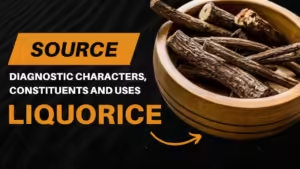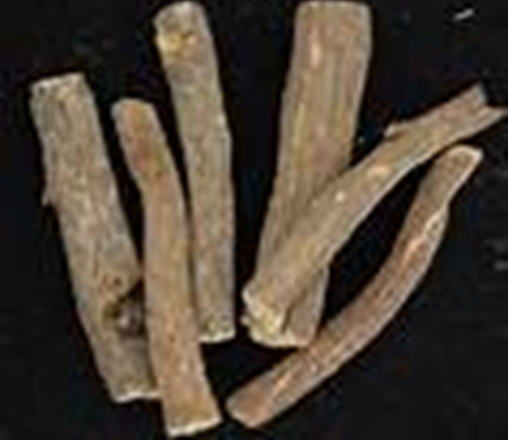Liquorice
Source, diagnostic characters, constituents and uses

Objectives
At the end of this lecture, student will be able to
• Steroidal Saponins
• Source, diagnostic characters, constituents and uses of Liquorice
Steroidal Saponins
• Medicinally and commercially important
• Aglycone – soap like action
• Foamin property, colloidal solutions
• Haematotoxic- cause haeolysis; used as fish poisons
• Non crystalline, soluble in water and alcohol, insoluble in organic solvents
• Aglycone – Sapogenin
• Harmful sapogenin – sapotoxins
• Steroidal saponins (Tetracyclic triterpenoid saponins)
– Raw material for various medicinally useful steroids
• Pentacyclic triterpenoid saponins
• Aglycone + sugars or uronic acid
• Sapogenin types – α-amyrin, β-amyrin and lupeol
Liquorice
Synonym
• Glycyrrhiza, Glycyrrhizae radix, Mulethi
Source:
• Dried roots and stolons of Glycyrrhiza glabra and other species of Glycyrrhiza
Family
• Leguminosae
Cultivation and Collection of Liquorice
• Propagation– vegetative, stolon with 2-3 buds
• Deep sandy soil, well prepared, farmyard manures added
• Stolon planted in March
• Fertilizers applied during the development of green parts
• Crops kept weed free
• Roots dug after 3-4 yrs in October
• Buds, rootlets removed
• Washed, dried in sun, then under shade
Morphology:
• Condition: Dry, occurs in peeled or unpeeled form
• Shape: Straight, nearly cylindrical (unpeeled) or angular (peeled)
• Surface: Yellowish brown with longitudinal wrinkles (unpeeled), peeled one are yellow coloured with fine longitudinal ridges. In case of stolons, scars of buds can be seen
• Size: 20-50cm long and 1-2cm in diameter
• Fracture: Coarsely fibrous in bark region and splintery in wood
• Odour: Characteristic, Taste: Sweet
Microscopy of Liquorice
Powder characters of Liquorice
Organoleptic characters: Taste, Colour, odour, taste
• Fibres
• Calcium oxalate (twin prisms)
• Wood elements
• Starch grains
Constituents of Liquorice
• Triterpenoidal saponin glycosides – Glycyrrhizin (3-9%), which is calcium and potassium salt of glycyrrhizinic acid
– Glycyrrhizinic acid on hydrolysis yields Glycyrrhetinic acid
• Bitter principle: Glycyramarin
• Flavonoid Glycosides: Liquiritin, Isoliquiritin, Liquiritigenin, Isoliquiritigenin
• Asparagin, fat
Test for Liquorice
• Thick section or powder + 80% sulphuric acid – deep yellow colour
Varieties
• G. glabra var. typica – Spanish liquorice
• G. glabra var.glandulifera – Russian liquorice
• G. glabra var. violacea – Persian liquorice
• Machurian liquorice – G. uralensis
Uses of Liquorice:
• Demulcent (Soothing), Sweetening agent
• Expectorant
• Treatment of Peptic ulcer, Spasmolytic agent
Also, visit B. Pharma Notes in PDF Free Download.



